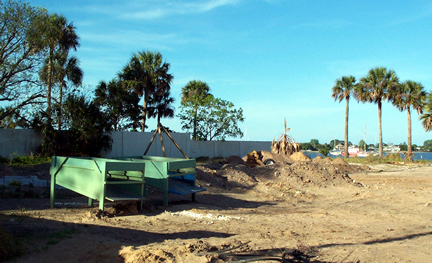Threatened Structures
Threatened Features
La Punta Community
Mission Archeological Site
The
City’s Civil Rights
Landmarks
Threatened Districts

The mission settlement of Nuestra Senora del Rosario de la Punta was one of
the last Native American communities in the St. Augustine area. Founded in
the late
1720s, primarily by displaced Yamassee Indians, the community consisted of
around 20 dispersed farmsteads and a mission church, all just outside the
colonial-walled
city.
Archaeological investigations by the City of St. Augustine at the corner of Tremerton and Marine Streets discovered a burial site for the residents of the mission community whose population was estimated at between 40 to 60 people during its 30 or so year occupation. It is estimated that more than 100 men, women and children of Native American and possibly other descent are buried under what had once been the small mission church. The graves followed Christian burial practices and were used repeatedly, resulting in a high concentration of remains in a small area.
The cemetery is located on one of the lots that is part of an eight-lot parcel of land being developed as the waterfront gated community of Bonita Bay. It is has been suggested that possibly one of two things could occur: the cemetery could remain in place and be turned into a historic pocket park, or it could be excavated in its entirety and removed to another location for reburial.
This graveyard is highly significant because it is symbolic of St. Augustine’s colonial heritage, a heritage that fostered a synergism between Europeans, Native Americans, and Africans. This resulted in this unique Spanish cosmopolitan community—one that is promoted by the city’s tourism industry. The human remains also represent one of the last vestiges of an extensive Native American population that lived in what is today Georgia and Florida prior to European colonization. The city has no provision to protect rare archeological finds such as this from destruction and, sadly, the loss of this important burial ground through urban redevelopment seems imminent.